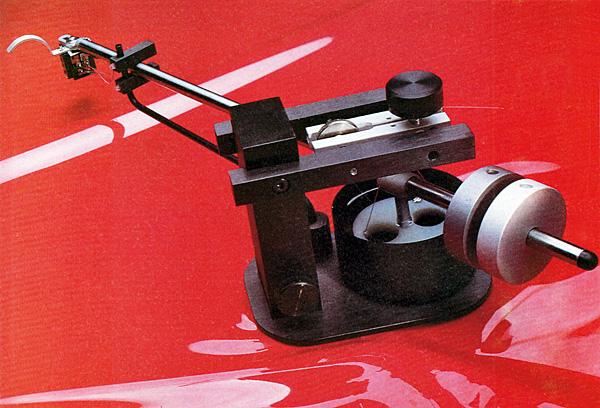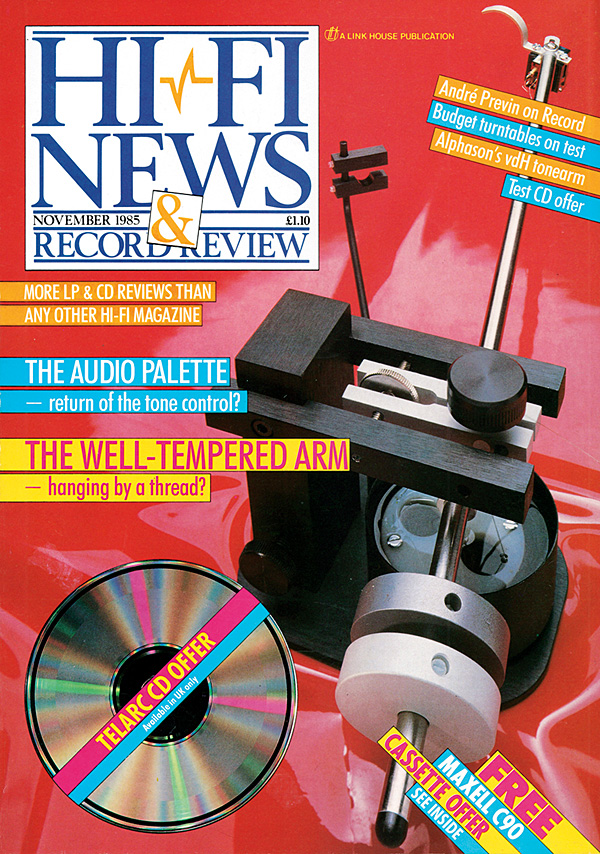Prelude & Fugue

What could be more apt than the UK launch of the Well-Tempered Arm at the end of Bach's tercentenary year? Ken Kessler brought you the first picture of this iconoclastic tonearm as part of his April '85 CES report and even before then, he had inveigled California-based designer William Firebaugh into letting us have a review sample.
Everyone knows a good tonearm has to have expensive precision bearings, a large diameter armtube with a rigid cartridge platform and that the energy path must be correctly 'earthed' via tonearm cable anchorage. The WTA has none of those features – its 'bearings' must be worth all of 10p, comprising merely a looped suspension thread of fine nylon. The stainless steel arm tube, just 6mm in overall diameter (granular filled to reduce resonances), is closed at one end by a slotted mounting block, with cartridge platform reduced simply to a 1.2mm-thick finger lift, tapped to receive a single small fixing screw. The fine Litz wires used are twisted together to pass in a loop from the back of the pivot to a surface-fixed junction box, with two phono sockets and ground connector. This leaves the choice of tonearm-to-preamp cable open – I used van den Hul D202. The separate earth lead is only necessary to prevent hum when touching the arm metalwork. Two counterweights are supplied, and these have a material bearing on the resultant sound.

Treacle Treat
Whatever the criticisms of the aesthetics of the design, the arm does work superbly. lt is no Transcriptors 'Vestigal' (sic!). lt has ousted the Zeta from my system, as a perfect carrier for the Garrott-Deccas, and with moving-coils such as the Empire MC1000 and the altogether delightful Goldbug Clement II, soundstaging and tracking performance have been exemplary. Those MCs are, incidentally, boron cantilever cartridges of high compliance. As to how the WTA's suspension works,
I have been suggesting the analogy of being on a swing with your seat in a vat of treacle! The 29cm-long armtube has a sleeve fixed 7cm from one end, with a short vertical spindle set on a circular horizontal paddle, with two circular cutouts.
The paddle is fully immersed in a cup of silicone damping fluid, and from the outer edges of the paddle the suspension thread runs from a fixed anchorage on one side to a take-up spiral mechanism on the other. In fact the threads are not vertical but inclined and crossed in an inverted 'V'. They pass through two vertical drillings in a pair of adjustable aluminium bars, and when the tonearm is at the end-of-side these suspension points are aligned with the axis of the arm.
Rather as with inertia seat-belts, the viscosity of the silicone gives astonishing 'rigidity' to the arm. If you pull forwards, the turntable suspension will deflect just as it would with a conventional bearing tonearm. Going back to my analogy of the child's swing: if the ropes converged to a single point then clearly it could easily rotate, but resistance to side-to-side motion would increase as the ropes assumed a divergence. Mr Firebaugh cunningly exploits this to effect bias correction: the aluminium bars are carried in the overall gantry with a threaded rod/thumbwheel arrangement, as found in a draughtsman's spring bow compass. Moving the centres of the bars apart counters the stylus' tendency for inward movement towards the turntable spindle.

One-Piece Post
The whole assembly comprises a baseplate carrying the damping fluid container, the suspension gantry, and a tonearm rest – there is no lift/lower device. The tonearm is supported on a shaped aluminium cradle, with a locking bar over: these are adjustable on a twice-bent rod, set with the Allen key provided into its arm-base thimble, at the required angle relative to tonearm board. The whole is carried on a one-piece post, threaded at one end, and with a spanner grip at the top. The post is V-grooved, and the arm height is varied simply by raising or lowering it to achieve the desired VTA and locking it with a single knurled screw (by thumb and forefinger). As the post is not concentric with the nominal point about which the tonearm pivots, the orientation of the V-groove must be decided during installation, as turning it will alter the overhang, and introduce tracking error.
The gantry height, which averages 9.5cm on a Linn LP12, and the long counterweight rod mean that on some turntables there will be an oversail at the back of the plinth and that the lid depth will be inadequate. In any case, the leadout wires to the junction box, which has adhesive tabs for plinth fixing, must be dressed to obviate compromise of arm freedom, and these could be strained by the lid-rim. So there's no lid!
Aesthetic Criticisms
Anyone who has seen the designer's patent application diagrams [see overleaf] will conclude that William Firebaugh has a wry sense of humour, for they are in the manner of an Albrecht Durer, or Leonardo da Vinci. Where the WTA fails is in a coherence of style. The black gantry has debts to Rietveld, or Piet Mondrian, but the Bauhaus expressionism is then wed to Swiss post-war functional elegance in the stainless steel armtube and counterweight, with a touch of Japanese understatement in the arm rest.

I find the rectangular baseplate and the way the three elements relate, gantry, silicone container, and armrest thimble, has a grimness about it. Then there are the spidery lead-out wires, too fragile to tease out for fear of fracturing at the cartridge tags. The tags are formed with slotted spring leaves, giving an almost square-shaped section. Ingenious in principle, they are too thin for good grip and tend to rock on any cartridge with short pins.
Indeed, on the Decca mount, with its close-spaced pins I even experienced shorting-out of one channel during play. lt was necessary to sheathe the centre pin in a plastic sleeve.
Since the early UK samples there have been some cosmetic improvements. I'll list them, as the WTA has been on dem at Jim Dovey's Acoustic Arts shop in Watford for some months. The armtube is now continuous stainless steel, whereas at one time the pivot/rear stem was in black plastic; the finger-lift platform is now more elegantly shaped and finished; armrest blocks are in black; the gantry is in a brushed black anodising with an attractive sheen; and the counterweight quality is improved. Also, the junction box should by now have been upgraded from plastic to aluminium, and phono sockets from nickel to gold plated. Incidentally, the WTA has one endearing trait: it is self parking. Set the arm on its rest and it glides back automatically, then drops into its cradle.
























































